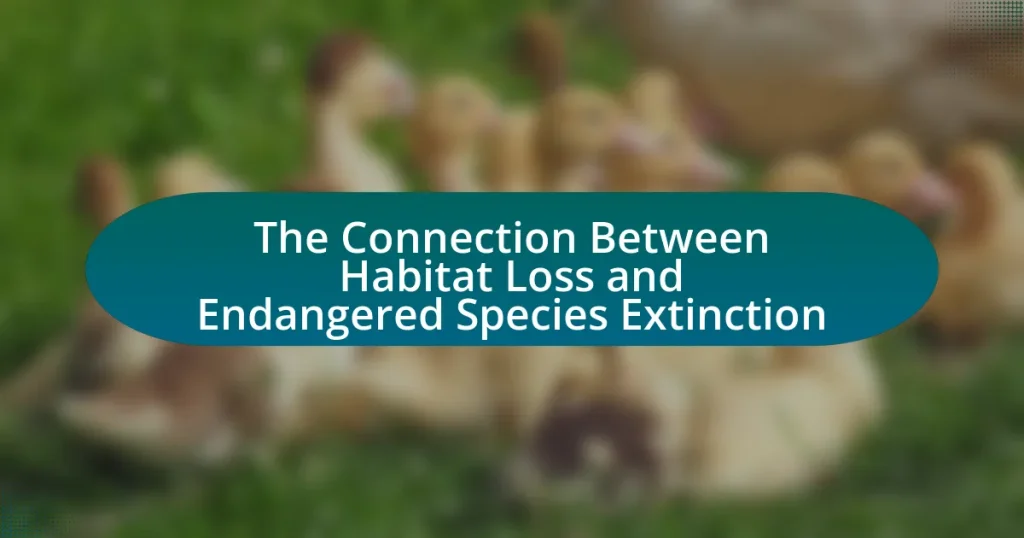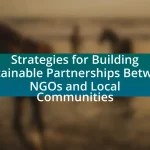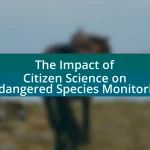The article examines the critical relationship between habitat loss and the extinction of endangered species, highlighting how the destruction and fragmentation of natural environments due to human activities such as deforestation, urbanization, and agriculture directly threaten biodiversity. It details the primary causes of habitat loss, including climate change, and discusses the implications for species survival, genetic diversity, and ecosystem stability. The article also emphasizes the socio-economic consequences of biodiversity loss and outlines strategies for mitigating habitat loss, such as habitat restoration, the establishment of protected areas, and community engagement in conservation efforts. Overall, it underscores the urgent need for effective conservation measures to protect endangered species and maintain ecosystem health.
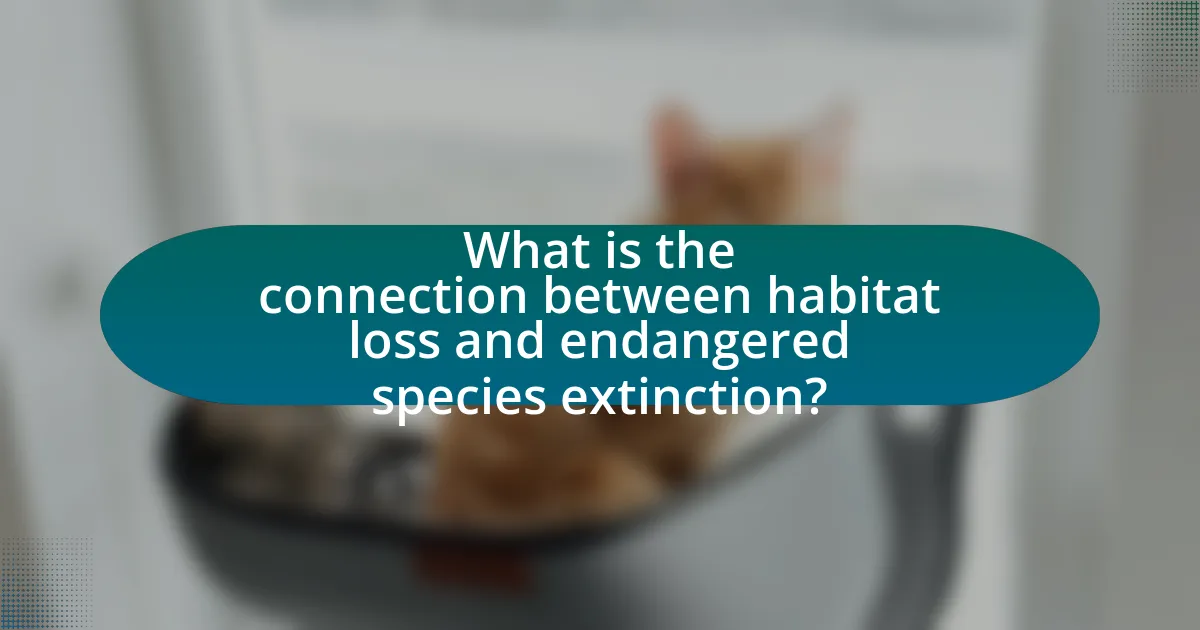
What is the connection between habitat loss and endangered species extinction?
Habitat loss directly contributes to the extinction of endangered species by eliminating the natural environments necessary for their survival. When habitats are destroyed or fragmented due to human activities such as deforestation, urbanization, and agriculture, species lose their homes, food sources, and breeding grounds. According to the International Union for Conservation of Nature (IUCN), habitat loss is one of the primary drivers of species extinction, with over 80% of threatened species experiencing habitat degradation. This loss of habitat reduces biodiversity and disrupts ecosystems, making it increasingly difficult for endangered species to recover and thrive.
How does habitat loss impact biodiversity?
Habitat loss significantly reduces biodiversity by destroying the natural environments that species rely on for survival. When habitats are altered or eliminated, many species face extinction due to the loss of food sources, shelter, and breeding grounds. For instance, the World Wildlife Fund reports that habitat destruction is a primary driver of species decline, with approximately 1 million species at risk of extinction largely due to habitat loss. This decline in biodiversity disrupts ecosystem functions, leading to decreased resilience against environmental changes and loss of ecosystem services that are vital for human well-being.
What are the primary causes of habitat loss?
The primary causes of habitat loss include deforestation, urbanization, agriculture, and climate change. Deforestation, driven by logging and land conversion for agriculture, results in the destruction of forests, which are critical ecosystems for numerous species. Urbanization leads to the expansion of cities, fragmenting habitats and reducing available space for wildlife. Agriculture, particularly intensive farming practices, alters landscapes and depletes natural habitats. Climate change exacerbates these issues by altering weather patterns and affecting species’ ability to adapt, further contributing to habitat degradation. According to the World Wildlife Fund, approximately 1 million species are at risk of extinction due to habitat loss, highlighting the urgent need for conservation efforts.
How does habitat fragmentation affect species survival?
Habitat fragmentation negatively impacts species survival by isolating populations, reducing genetic diversity, and limiting access to resources. When habitats are divided into smaller, disconnected patches, species may struggle to find mates, leading to inbreeding and decreased resilience to environmental changes. Research indicates that fragmented habitats can lead to a 70% reduction in species richness, as seen in studies conducted in tropical rainforests, where habitat loss has resulted in significant declines in bird and mammal populations. This evidence underscores the critical link between habitat fragmentation and the increased risk of extinction for many species.
Why are certain species more vulnerable to extinction?
Certain species are more vulnerable to extinction primarily due to their specialized habitat requirements and limited geographic ranges. For instance, species that rely on specific ecosystems, such as coral reefs or old-growth forests, face heightened risks when those habitats are threatened by human activities like deforestation or climate change. According to the International Union for Conservation of Nature (IUCN), approximately 80% of species listed as endangered are affected by habitat loss, which disrupts their breeding, feeding, and sheltering needs. Additionally, species with small populations are more susceptible to extinction due to genetic bottlenecks and reduced reproductive success, further compounding their vulnerability.
What role does habitat specificity play in species vulnerability?
Habitat specificity significantly increases species vulnerability by limiting their ability to adapt to environmental changes and habitat loss. Species that are highly specialized to particular habitats often have narrow ecological niches, making them more susceptible to extinction when those habitats are altered or destroyed. For example, the California condor, which relies on specific nesting sites and food sources, faced drastic population declines due to habitat destruction and is now critically endangered. This relationship underscores that species with low habitat specificity tend to have greater resilience, as they can exploit a wider range of environments and resources, thereby reducing their risk of extinction.
How does the loss of keystone species influence ecosystems?
The loss of keystone species significantly disrupts ecosystems by altering species composition and ecosystem functions. Keystone species, such as sea otters and wolves, play critical roles in maintaining the structure and balance of their environments. For instance, the decline of sea otters in kelp forest ecosystems leads to an increase in sea urchin populations, which in turn devastates kelp forests, resulting in loss of habitat for numerous marine species. Similarly, the removal of wolves from Yellowstone National Park caused an overpopulation of elk, which overgrazed vegetation, leading to soil erosion and decreased biodiversity. These examples illustrate that the absence of keystone species can trigger cascading effects, destabilizing entire ecosystems and diminishing their resilience.

What are the consequences of habitat loss on endangered species?
Habitat loss leads to significant consequences for endangered species, primarily resulting in population decline and increased risk of extinction. When natural habitats are destroyed or fragmented, the availability of food, shelter, and breeding grounds diminishes, directly impacting the survival rates of these species. For instance, the International Union for Conservation of Nature (IUCN) reports that habitat loss is a primary driver of extinction for over 80% of threatened species. Additionally, habitat loss can lead to genetic isolation, making it difficult for populations to interbreed, which further reduces genetic diversity and resilience. This cycle of decline can ultimately result in the extinction of species that are unable to adapt to the rapidly changing environment.
How does habitat loss lead to population decline?
Habitat loss leads to population decline by reducing the available living space and resources necessary for species survival. When natural habitats are destroyed or fragmented, organisms face increased competition for food, shelter, and mating opportunities, which can result in decreased reproductive success and higher mortality rates. For instance, studies show that habitat destruction can lead to a 50% reduction in species populations within just a few generations, as seen in the case of the Amazon rainforest, where deforestation has significantly impacted biodiversity. This loss of habitat not only threatens individual species but also disrupts entire ecosystems, further exacerbating population declines.
What are the effects of reduced food availability on species?
Reduced food availability negatively impacts species by leading to decreased survival rates, lower reproductive success, and increased competition for resources. For instance, studies show that herbivores like deer experience population declines when food sources are scarce, resulting in lower birth rates and higher mortality. Additionally, predators may struggle to find sufficient prey, which can lead to starvation and reduced population sizes. Research indicates that in ecosystems where food availability is compromised, such as due to habitat loss, species diversity declines, further destabilizing the ecosystem.
How does habitat loss affect breeding and reproduction?
Habitat loss significantly disrupts breeding and reproduction by reducing the availability of suitable nesting sites and food resources. When animals lose their natural habitats, they often face increased competition for limited resources, which can lead to lower reproductive success. For instance, studies have shown that species like the California condor have experienced decreased breeding rates due to habitat fragmentation, which limits their access to necessary resources and safe nesting areas. Additionally, habitat loss can lead to population declines, making it more difficult for species to find mates, further exacerbating reproductive challenges.
What are the long-term implications of species extinction?
The long-term implications of species extinction include significant disruptions to ecosystems, loss of biodiversity, and negative impacts on human livelihoods. Ecosystems rely on a balance of species for functions such as pollination, nutrient cycling, and habitat stability; the extinction of a species can lead to cascading effects that destabilize these systems. For instance, the extinction of pollinators like bees can reduce crop yields, affecting food security and economies reliant on agriculture. Furthermore, biodiversity loss diminishes resilience against environmental changes, making ecosystems more vulnerable to climate change and disease outbreaks. According to the Intergovernmental Science-Policy Platform on Biodiversity and Ecosystem Services (IPBES), around 1 million species are currently threatened with extinction, which underscores the urgency of addressing habitat loss and its connection to species survival.
How does the extinction of species impact ecosystem services?
The extinction of species significantly disrupts ecosystem services, which are the benefits that humans derive from ecosystems. When species disappear, the balance of ecosystems is altered, leading to reduced biodiversity, which is crucial for processes such as pollination, nutrient cycling, and water purification. For instance, the loss of pollinators like bees can lead to decreased crop yields, affecting food security and agricultural economies. Additionally, the extinction of keystone species, such as sea otters, can result in the overpopulation of certain species, which can degrade habitats and diminish the overall health of ecosystems. Studies have shown that ecosystems with higher biodiversity are more resilient and better able to withstand environmental changes, highlighting the critical role that species play in maintaining ecosystem services.
What are the socio-economic consequences of losing biodiversity?
Losing biodiversity leads to significant socio-economic consequences, including reduced ecosystem services, increased vulnerability to natural disasters, and economic losses in sectors like agriculture and tourism. Ecosystem services, such as pollination, water purification, and climate regulation, are essential for human survival and economic stability; their decline can result in decreased agricultural productivity and higher food prices. For instance, the Food and Agriculture Organization reported that biodiversity loss can reduce crop yields by up to 40%, directly impacting food security and livelihoods. Additionally, the loss of biodiversity can exacerbate the effects of climate change, making communities more susceptible to extreme weather events, which can lead to costly damages and displacement. In tourism, regions that rely on diverse ecosystems for attractions may experience declines in visitor numbers, leading to job losses and reduced income for local economies. Thus, the socio-economic ramifications of biodiversity loss are profound and multifaceted, affecting food security, economic stability, and community resilience.
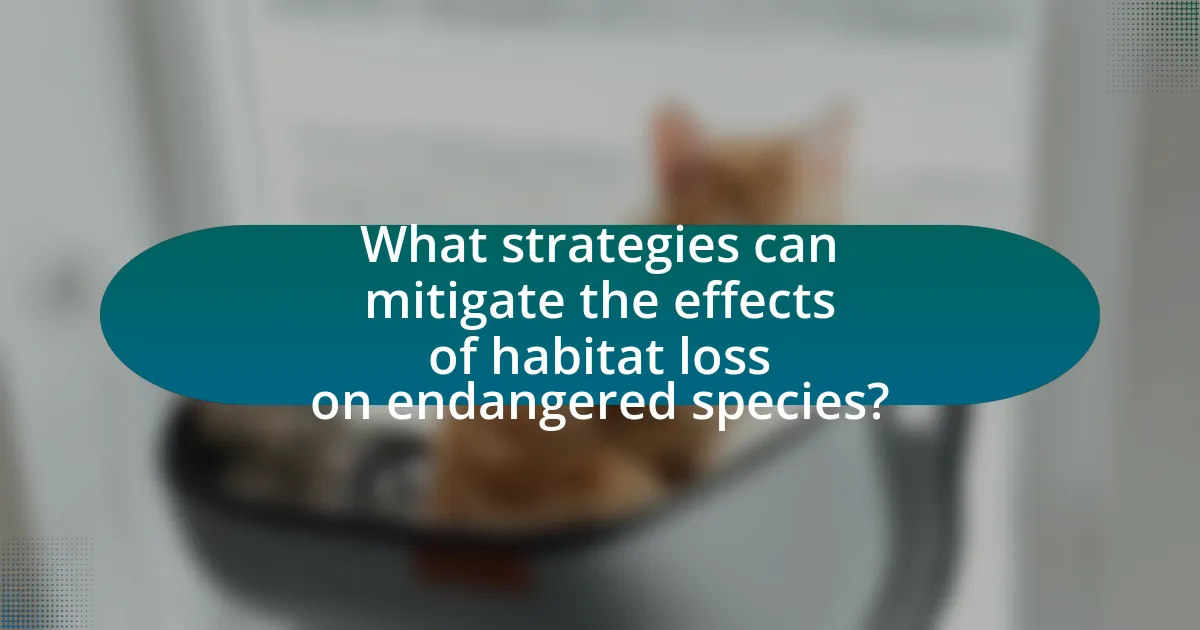
What strategies can mitigate the effects of habitat loss on endangered species?
To mitigate the effects of habitat loss on endangered species, implementing habitat restoration, establishing protected areas, and promoting sustainable land-use practices are essential strategies. Habitat restoration involves rehabilitating degraded ecosystems, which can enhance biodiversity and provide critical resources for endangered species. Establishing protected areas, such as national parks and wildlife reserves, helps safeguard habitats from development and human encroachment, ensuring that species have safe environments to thrive. Promoting sustainable land-use practices, such as agroforestry and responsible forestry, reduces habitat destruction while allowing for economic development. These strategies are supported by research indicating that protected areas can significantly increase species populations and biodiversity, as evidenced by a study published in “Conservation Biology” which found that protected areas help maintain ecosystem integrity and resilience.
How can conservation efforts help protect endangered species?
Conservation efforts can help protect endangered species by preserving their natural habitats and implementing targeted recovery programs. These initiatives often involve habitat restoration, legal protection of critical areas, and the establishment of wildlife reserves, which directly address the primary cause of endangerment: habitat loss. For instance, the establishment of protected areas has been shown to increase species populations; a study published in the journal “Conservation Biology” found that protected areas can lead to a 50% increase in species richness. Additionally, conservation programs often include breeding and reintroduction efforts, which have successfully revived populations of species such as the California condor and the Arabian oryx. These concrete actions demonstrate that effective conservation strategies can significantly mitigate the risks faced by endangered species.
What role do protected areas play in habitat preservation?
Protected areas play a crucial role in habitat preservation by providing designated spaces where ecosystems can thrive without the pressures of human development and exploitation. These areas help maintain biodiversity by protecting the habitats of numerous species, thereby reducing the risk of extinction. For instance, according to the International Union for Conservation of Nature (IUCN), protected areas cover approximately 15% of the Earth’s land surface and are home to over 80% of the world’s terrestrial biodiversity. This statistic underscores the effectiveness of protected areas in safeguarding vital habitats and promoting ecological resilience.
How can restoration ecology contribute to species recovery?
Restoration ecology can significantly contribute to species recovery by rehabilitating degraded habitats, thereby providing essential resources and conditions for endangered species to thrive. By restoring native vegetation, improving soil quality, and re-establishing natural water flows, restoration projects create suitable environments that support the life cycles of various species. For instance, a study published in the journal “Ecological Applications” by Suding et al. (2015) demonstrated that habitat restoration efforts led to a 50% increase in the populations of several threatened plant species in the restored areas. This evidence underscores the effectiveness of restoration ecology in reversing the impacts of habitat loss and facilitating the recovery of endangered species.
What actions can individuals take to support habitat conservation?
Individuals can support habitat conservation by participating in local conservation efforts, such as volunteering for habitat restoration projects. Engaging in activities like tree planting, invasive species removal, and clean-up events directly contributes to the health of ecosystems. Additionally, individuals can advocate for policies that protect natural habitats by contacting local representatives and supporting conservation organizations. Research indicates that community involvement in conservation can lead to improved biodiversity and ecosystem resilience, as seen in studies conducted by the World Wildlife Fund, which highlight the positive impact of grassroots initiatives on habitat preservation.
How can community engagement enhance conservation efforts?
Community engagement enhances conservation efforts by fostering local stewardship and increasing awareness of environmental issues. When communities actively participate in conservation initiatives, they are more likely to develop a sense of ownership and responsibility towards their local ecosystems. Research indicates that community-led conservation projects, such as those documented in the “Community-Based Conservation: A Review of the Evidence” by Bertram and Vivier, show improved biodiversity outcomes and habitat restoration. Engaged communities can also mobilize resources, share traditional ecological knowledge, and advocate for sustainable practices, which collectively contribute to more effective conservation strategies.
What are effective practices for sustainable land use?
Effective practices for sustainable land use include implementing agroforestry, promoting crop rotation, and utilizing conservation tillage. Agroforestry integrates trees and shrubs into agricultural landscapes, enhancing biodiversity and soil health. Crop rotation prevents soil depletion and reduces pest outbreaks, contributing to ecosystem stability. Conservation tillage minimizes soil erosion and maintains soil structure, which is crucial for supporting diverse plant and animal life. These practices collectively help mitigate habitat loss, which is a significant factor in the extinction of endangered species.
